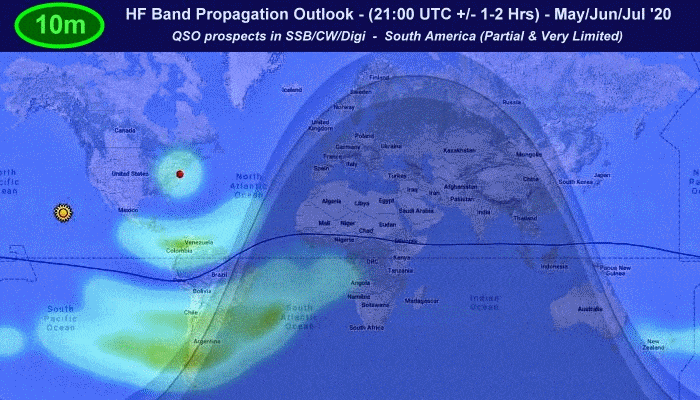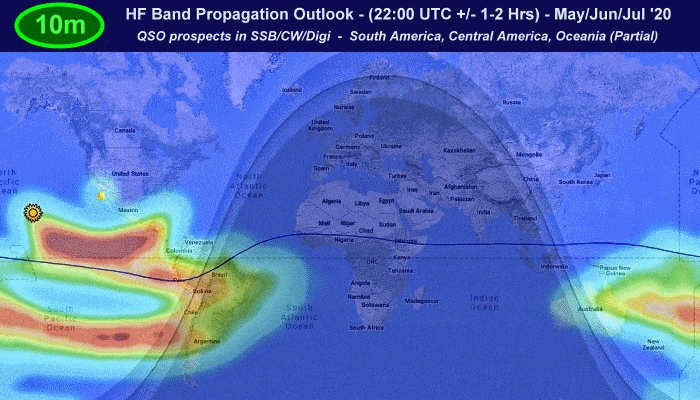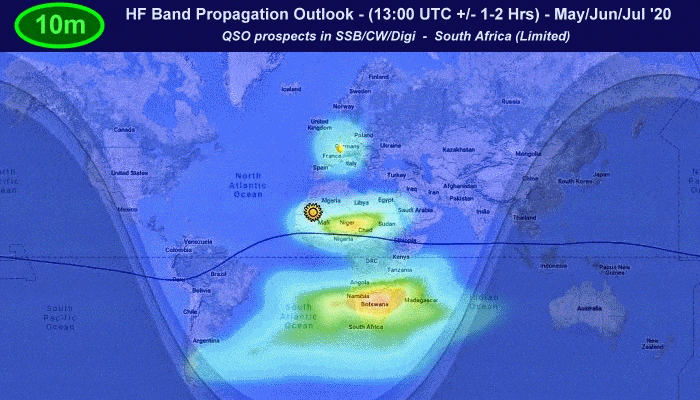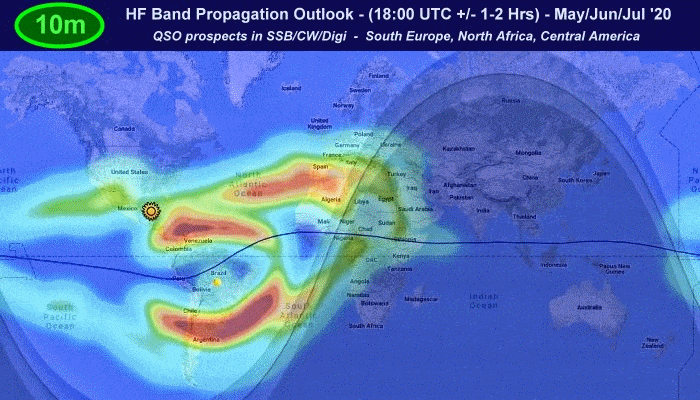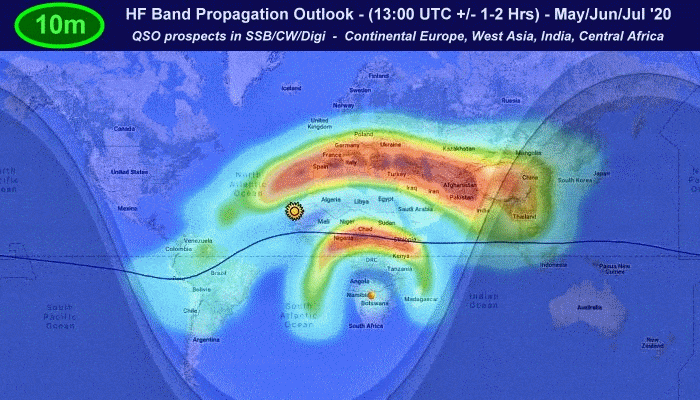HF Radio Propagation Outlook – The Summer of 2020
For our friends living on the Southern side of the Equator, the phrase, Summer of 2020, may not sound right because it is the winter for them. I totally acknowledge this reality but would request them to bear with me on this matter with regards to this narrative… The summer of 2020 implies the months of May, June, and July of the year 2020.
The bottom line is that due to the weak solar activity which results in lower ionospheric plasma densities on earth, the HF radio propagation to various locations around the world is not easily viable at all times. However, with the selection of correct time, frequency band, and with some extra care in setting up an antenna and the transmission line, HF radio communication even during low SSN can be a surprisingly fulfilling experience… Please also check out the article Are HF Bands Really Dead during Low SSN at Solar Cycle Minima?
Despite the fact that HF radio propagation conditions may not be easy, it is also equally true that HF bands are NOT dead. HF DX communication to most locations around the world is possible not only on CW or Digi-modes but all on SSB Radiotelephony if a proper frequency band and a proper time of the day is chosen. To achieve this, it is important to know when the band openings occur and how to leverage the conditions to our advantage.
This post is a part of a quarterly feature on this website where I will try to present the most probable and viable HF radio propagation prospects on various amateur radio bands for operators residing in various different parts of the world. HF radio propagation outlook for the entire world will be presented for the quarterly periods of summer, fall, winter, and spring of each year.
Limiting Factors for HF Radio Propagation during Summer of 2020
There are a few common limiting factors that typically have an adverse influence on HF radio communication. While the conditions are good during the high SSN phase of the solar cycle, nobody bothers to think about these limitations. However, when the conditions are poor and not really conducive for a 24×7 type of robust communication, then we need to start paying extra attention to these limiting factors and try to minimize their negative effects… Low SSN phase of the solar cycle that we are encountering now during the summer of 20 is one such situation.
Under conditions of healthy solar activity with reasonable SSN, the earth’s ionospheric plasma density is sufficient to usually allow efficient skywave skip propagation during most of the day/night on several amateur HF radio bands simultaneously. Typically under such conditions, only a few watts of RF power on an appropriate band may allow worldwide radio communication even while using a simple wire antenna. That is the reason why a typical 100W PEP (called barefoot) output from an HF transceiver is more than sufficient o provide several orders of magnitude of higher RF power than what is generally necessary to establish reliable communication. We invariably have at our disposal at least 15-18 dB, if not more of extra RF power margin than what is needed.
As a consequence of the above-cited facts, we manage to happily get through to our destinations even with an inefficient antenna, or an unduly high radiation take-off angle, or a recklessly deployed transmission lines that produce excessive Common-Mode Current (CMC) noise, or an atrociously elevated receiver noise-floor at our transceiver due to sub-optimally setup ham shack, etc, etc, etc…
During the low SSN phase like what we have now, during the summer of 2020, we need to tighten our belts because we no more have the luxury of super-wide SNR margins that we had when the conditions were good. We no more have any room for inefficiencies, unwarranted noises, and avoidable degradation of SNR… Those who do tighten their belts, manage to work DX very frequently on SSB/CW and other regular modes without having to resort to weak-signal, non-conversational, and mundane modes like the FT8 even though finding and working DX might be more challenging than usual… Those who do not care to tighten their belts and put their acts together are usually heard complaining that the bands are dead or heard boasting about how they were busy working on FT8.
I have extensively covered all the above-cited factors that are known to adversely affect HF radio communication in fair detail in several separate articles and posts on this website, Therefore, I will refrain from dwelling any deeper into them over here but leave it to the reader to find and peruse them at leisure if they wish. For the moment, just keep in mind the following…
- Pay special attention to the height of your antenna above ground and also ensure clearance around the antenna from nearby water-pipes, electric-wires, metal structures, RCC concrete (with embedded steel rod mesh) pillars/beams/floor/roof, etc.
- Close proximity of the antenna elements to any of the above-cited objects would adversely affect the antenna radiation pattern and introduce additional absorption loss.
- At least 1/2 λ clearance from most of the above objects is the minimum requirement for an average antenna. However, for best results, try to maintain clearances of around 1-2 λ.
- Don’t feel disappointed if you are unable to install a bigger and a higher gain antenna due to any constraint. Even a simple wire antenna like a Dipole that is installed with care after doing due diligence might outperform a mediocre installation of a bigger antenna.
- The mantra is to not obsess with antenna gain but to attain good radiation efficiency and more importantly a low radiation take-off angle by installing the antenna as high as possible above ground.
- Most importantly, check the quiescent noise-floor level on each band on your transceiver with the antenna connected. Depending on where you live, it should be no more than S1-S3 on 20-17-15-12-10m bands and it should be below S4-S6 on 40m. If the quiescent noise level is higher than this, then your antenna system is likely to be grossly inadequate. You would need to revisit your antenna installation and especially focus on the transmission line.
- The excessive HF noise floor issues are either due to a poorly selected antenna location or more often it is due to excessively high Common-Mode current (CMC) on the transmission line. Take corrective measures to eliminate the unwanted noise and thereby significantly improve your prospects of working HF DX even under low SSN conditions.
Remember that when an average radio amateur is unable to work regular SSB radiotelephony or CW, while he can easily work FT8 during low solar activity conditions, it’s not necessarily a miracle of FT8. It is quite often an indication of inadequacies in the radio station set up. One might say, I have the latest and the best rig that money can buy. So, how can my radio station be inadequate? Unfortunately, the adequacy of a radio station is not so much dependant on the rig but rather on the quality of installation of the antenna (even if the antenna might be a simple dipole) and also on the compatibility between the antenna and the transmission line with regard to its electrical balance (CMC reduction) and impedance match characteristics.
It’s no rocket science but simple common-sense… If you cut down your station’s HF quiescent noise level by 2-3 S-units by simply optimizing your antenna and transmission line, you would improve the SNR by 12-18 dB. You may now be able to easily copy CW and SSB voice transmissions, while you could earlier only work FT8. Moreover, yet another antenna tweak, to even marginally lower the antenna take-off angle by increasing antenna height slightly might provide additional improvement in the SNR margin. All these small tweaks put together will do wonders. Once you are able to comfortably hear the DX station, you are most likely to be able to work him too… Think about it…
How to find HF Radio Propagation Openings in the Summer of 20
Since we have now confirmed that HF radio DXing on SSB/CW can actually be done even during the low ebb of the solar cycles, let us now focus on how to go about doing it. Assuming that the antenna setup is good and up to the mark as we discussed above, we are likely to find plenty of DX opportunities even during the summer of 2020 and even while running only a barefoot transceiver on the HF bands.
I concede that, unlike the times when the solar activity is good and the regular SSN is high, it is far easier to find HF radio propagation openings because they occur more frequently, strongly, and perhaps remain open for longer durations of time at a stretch. That is perhaps the reason why it is so easy to stumble upon a propagationally open band at most times while scanning for activity. Even a person without much understanding of HF radio propagation usually finds it a cakewalk.
However, mother nature is more finicky and throws up more challenges during the low SSN phase of solar cycles. This is when a better understanding of ionospheric behavior goes a long way to figure out HF radio propagation prospects…
In this article, I am going to provide simple presentations of prospective propagation openings that are likely to be available on various HF bands to radio operators around the world. The propagation outlook that I present is likely to hold reasonably well, on average, throughout the 3 month period of the season. Of course, there is bound to be a gradual shift in the timings of projected openings as well as their duration and strength, but more or less, the projected pattern will generally hold good.
Before you start digging below into the HF Radio propagation projections for the summer of 2020, please take a moment to read and understand the following points that are vital to draw better and more informed inferences from these projections.
1) All projections are made with reference to the general geographic location of the radio station operator. For instance, someone located in Europe should follow the projections made from Europe, while someone in New Zealand should only follow the relevant projection from Oceania, etc.
2) Since all projections are broad regional projections, one might expect a certain amount of variation in actual HF radio propagation conditions in comparison to what is projected in our propagation outlook. The amount of variation will be proportionate to the distance between the point of projection to the actual QTH location. Despite this factor, the overall validity of the projections are expected to hold reasonably well for all operators from that region.
3) A special case where the variation from the projected propagation might be substantial would be the Skip-Zone regions. The Skip-zone around is a short-range around the QTH and hence it will shift according to the exact station QTH. For instance, the 20m band projection for Europe shows a lack of propagation into France or Germany, however, let us say, if the European operator were to be in Stockholm Sweden, then there will be good propagation into those countries while Sweden, Norway, and Finland might fall in the Skip-Zone… The bottom line is that the difference in short-distance propagation projections might be significant but the DX outlook would remain nearly identical and valid in most cases.
4) To get started with the HF radio propagation projection for your QTH, choose the region as applicable from the collapsable HF radio propagation display selector. When you select the region that is relevant to you, a series of 4 propagation map projections covering 10-15-20-40m bands will be presented in a cyclic order with a time-lapse of 5 seconds between each display slide. Each selector option specifies the continent as well as the projection point that is specified in parenthesis. You will also be able to see the actual projection point on the propagation outlook map projections that would become visible.
5) Propagation outlook from each region is projected in the form of an animated rotation. I have covered 4 different bands that include 40m, 20m, 15m, and 10m. The intermediate WARC bands like 30m, 17m, and 12m have not been included. However, with a little experience, one would find it easy to interpolate between the projections of two neighboring bands and arrive a good estimate for the WARC bands.
6) Each projection that I have provided are based on best and the widest-ranging opening prospect on each band. However, this does not imply that you will not find openings at other times. The expected time of band openings is specified in UTC along with ΔT which represents the expected variation in the time of occurrence of the band opening as well as the expected duration for it to last. ΔT is only a broad timespan indicator.
7) Each map displays the relevant HF radio propagation outlook for a band. The expected HF radio propagation quality is indicated by a multi-color heatmap superimposition. The map color at any DX location indicates the propagation prospects into that region from the operator’s QTH. Red color indicates strong propagation, while deep Blue color indicates an absolute lack of propagation. The colors ranging between Orange, Yellow, Green, Cyan, etc lie between Red and Blue. Hence, they represent progressively reducing signal strength (SNR) from a strong signal at Red to unworkable signal at Blue.
8) The most important fact to remember is that all propagation projections presented here have been normalized to Dipole antennas @35 ft. above ground that is assumed to be installed at both the TX and RX sites. If different types of antennas at different heights above the ground are used, they will present modified antenna behavior. As a result of which intensity of openings (SNR) at DX locations with change w.r.t. what we find according to the colors on the heatmap. In some instances, SNR might improve while in other cases, the SNR might reduce. Nevertheless, the overall pattern of band opening projections will remain almost the same.
9) Finally, here is the general indications of what magnitudes of SNR do various color of the heatmaps represent…
1) All projections are made with reference to the general geographic location of the radio station operator. For instance, someone located in Europe should follow the projections made from Europe, while someone in New Zealand should only follow the relevant projection from Oceania, etc.
2) Since all projections are broad regional projections, one might expect a certain amount of variation in actual HF radio propagation conditions in comparison to what is projected in our propagation outlook. The amount of variation will be proportionate to the distance between the point of projection to the actual QTH location. Despite this factor, the overall validity of the projections are expected to hold reasonably well for all operators from that region.
3) A special case where the variation from the projected propagation might be substantial would be the Skip-Zone regions. The Skip-zone around is a short-range around the QTH and hence it will shift according to the exact station QTH. For instance, the 20m band projection for Europe shows a lack of propagation into France or Germany, however, let us say, if the European operator were to be in Stockholm Sweden, then there will be good propagation into those countries while Sweden, Norway, and Finland might fall in the Skip-Zone… The bottom line is that the difference in short-distance propagation projections might be significant but the DX outlook would remain nearly identical and valid in most cases.
4) To get started with the HF radio propagation projection for your QTH, choose the region as applicable from the collapsable HF radio propagation display selector. When you select the region that is relevant to you, a series of 4 propagation map projections covering 10-15-20-40m bands will be presented in a cyclic order with a time-lapse of 5 seconds between each display slide. Each selector option specifies the continent as well as the projection point that is specified in parenthesis. You will also be able to see the actual projection point on the propagation outlook map projections that would become visible.
5) Propagation outlook from each region is projected in the form of an animated rotation. I have covered 4 different bands that include 40m, 20m, 15m, and 10m. The intermediate WARC bands like 30m, 17m, and 12m have not been included. However, with a little experience, one would find it easy to interpolate between the projections of two neighboring bands and arrive a good estimate for the WARC bands.
6) Each projection that I have provided are based on best and the widest-ranging opening prospect on each band. However, this does not imply that you will not find openings at other times. The expected time of band openings is specified in UTC along with ΔT which represents the expected variation in the time of occurrence of the band opening as well as the expected duration for it to last. ΔT is only a broad timespan indicator.
7) Each map displays the relevant HF radio propagation outlook for a band. The expected HF radio propagation quality is indicated by a multi-color heatmap superimposition. The map color at any DX location indicates the propagation prospects into that region from the operator’s QTH. Red color indicates strong propagation, while deep Blue color indicates an absolute lack of propagation. The colors ranging between Orange, Yellow, Green, Cyan, etc lie between Red and Blue. Hence, they represent progressively reducing signal strength (SNR) from a strong signal at Red to unworkable signal at Blue.
8) The most important fact to remember is that all propagation projections presented here have been normalized to Dipole antennas @35 ft. above ground that is assumed to be installed at both the TX and RX sites. If different types of antennas at different heights above the ground are used, they will present modified antenna behavior. As a result of which intensity of openings (SNR) at DX locations with change w.r.t. what we find according to the colors on the heatmap. In some instances, SNR might improve while in other cases, the SNR might reduce. Nevertheless, the overall pattern of band opening projections will remain almost the same.
9) Finally, here is the general indications of what magnitudes of SNR do various color of the heatmaps represent…
- RED – Strong SSB radiotelephony signal.
- ORANGE – Workable SSB radiotelephony signal.
- YELLOW – Strong CW with occasional radio telephony openings.
- GREEN – Comfortable CW signal.
- DARK GREEN – Workable CW signal.
- CYAN – In some cases, might work with FT8, JT65, etc.
- BLUE – Forget it! don’t waste your time…




